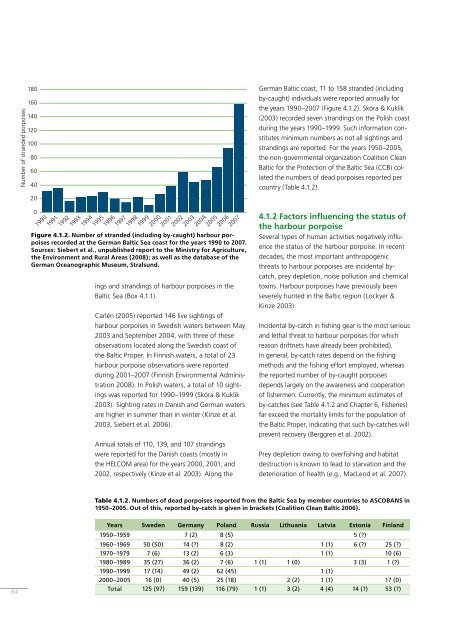BSEP116B Biodiversity in the Baltic Sea - Helcom
BSEP116B Biodiversity in the Baltic Sea - Helcom
BSEP116B Biodiversity in the Baltic Sea - Helcom
Create successful ePaper yourself
Turn your PDF publications into a flip-book with our unique Google optimized e-Paper software.
Number of stranded porpoises<br />
180<br />
160<br />
140<br />
120<br />
100<br />
80<br />
60<br />
40<br />
20<br />
0<br />
1990<br />
1991<br />
1992<br />
1993<br />
1994<br />
1995<br />
1996<br />
1997<br />
1998<br />
1999<br />
2000<br />
2001<br />
2002<br />
2003<br />
2004<br />
2005<br />
2006<br />
2007<br />
Figure 4.1.2. Number of stranded (<strong>in</strong>clud<strong>in</strong>g by-caught) harbour porpoises<br />
recorded at <strong>the</strong> German <strong>Baltic</strong> <strong>Sea</strong> coast for <strong>the</strong> years 1990 to 2007.<br />
Sources: Siebert et al., unpublished report to <strong>the</strong> M<strong>in</strong>istry for Agriculture,<br />
<strong>the</strong> Environment and Rural Areas (2008); as well as <strong>the</strong> database of <strong>the</strong><br />
German Oceanographic Museum, Stralsund.<br />
<strong>in</strong>gs and strand<strong>in</strong>gs of harbour porpoises <strong>in</strong> <strong>the</strong><br />
<strong>Baltic</strong> <strong>Sea</strong> (Box 4.1.1).<br />
Carlén (2005) reported 146 live sight<strong>in</strong>gs of<br />
harbour porpoises <strong>in</strong> Swedish waters between May<br />
2003 and September 2004, with three of <strong>the</strong>se<br />
observations located along <strong>the</strong> Swedish coast of<br />
<strong>the</strong> <strong>Baltic</strong> Proper. In F<strong>in</strong>nish waters, a total of 23<br />
harbour porpoise observations were reported<br />
dur<strong>in</strong>g 2001–2007 (F<strong>in</strong>nish Environmental Adm<strong>in</strong>istration<br />
2008). In Polish waters, a total of 10 sight<strong>in</strong>gs<br />
was reported for 1990–1999 (Skóra & Kuklik<br />
2003). Sight<strong>in</strong>g rates <strong>in</strong> Danish and German waters<br />
are higher <strong>in</strong> summer than <strong>in</strong> w<strong>in</strong>ter (K<strong>in</strong>ze et al.<br />
2003, Siebert et al. 2006).<br />
Annual totals of 110, 139, and 107 strand<strong>in</strong>gs<br />
were reported for <strong>the</strong> Danish coasts (mostly <strong>in</strong><br />
<strong>the</strong> HELCOM area) for <strong>the</strong> years 2000, 2001, and<br />
2002, respectively (K<strong>in</strong>ze et al. 2003). Along <strong>the</strong><br />
German <strong>Baltic</strong> coast, 11 to 158 stranded (<strong>in</strong>clud<strong>in</strong>g<br />
by-caught) <strong>in</strong>dividuals were reported annually for<br />
<strong>the</strong> years 1990–2007 (Figure 4.1.2). Skóra & Kuklik<br />
(2003) recorded seven strand<strong>in</strong>gs on <strong>the</strong> Polish coast<br />
dur<strong>in</strong>g <strong>the</strong> years 1990–1999. Such <strong>in</strong>formation constitutes<br />
m<strong>in</strong>imum numbers as not all sight<strong>in</strong>gs and<br />
strand<strong>in</strong>gs are reported. For <strong>the</strong> years 1950–2005,<br />
<strong>the</strong> non-governmental organization Coalition Clean<br />
<strong>Baltic</strong> for <strong>the</strong> Protection of <strong>the</strong> <strong>Baltic</strong> <strong>Sea</strong> (CCB) collated<br />
<strong>the</strong> numbers of dead porpoises reported per<br />
country (Table 4.1.2).<br />
4.1.2 Factors <strong>in</strong>fluenc<strong>in</strong>g <strong>the</strong> status of<br />
<strong>the</strong> harbour porpoise<br />
Several types of human activities negatively <strong>in</strong>fluence<br />
<strong>the</strong> status of <strong>the</strong> harbour porpoise. In recent<br />
decades, <strong>the</strong> most important anthropogenic<br />
threats to harbour porpoises are <strong>in</strong>cidental bycatch,<br />
prey depletion, noise pollution and chemical<br />
tox<strong>in</strong>s. Harbour porpoises have previously been<br />
severely hunted <strong>in</strong> <strong>the</strong> <strong>Baltic</strong> region (Lockyer &<br />
K<strong>in</strong>ze 2003).<br />
Incidental by-catch <strong>in</strong> fish<strong>in</strong>g gear is <strong>the</strong> most serious<br />
and lethal threat to harbour porpoises (for which<br />
reason driftnets have already been prohibited).<br />
In general, by-catch rates depend on <strong>the</strong> fish<strong>in</strong>g<br />
methods and <strong>the</strong> fish<strong>in</strong>g effort employed, whereas<br />
<strong>the</strong> reported number of by-caught porpoises<br />
depends largely on <strong>the</strong> awareness and cooperation<br />
of fishermen. Currently, <strong>the</strong> m<strong>in</strong>imum estimates of<br />
by-catches (see Table 4.1.2 and Chapter 6, Fisheries)<br />
far exceed <strong>the</strong> mortality limits for <strong>the</strong> population of<br />
<strong>the</strong> <strong>Baltic</strong> Proper, <strong>in</strong>dicat<strong>in</strong>g that such by-catches will<br />
prevent recovery (Berggren et al. 2002).<br />
Prey depletion ow<strong>in</strong>g to overfish<strong>in</strong>g and habitat<br />
destruction is known to lead to starvation and <strong>the</strong><br />
deterioration of health (e.g., MacLeod et al. 2007).<br />
Table 4.1.2. Numbers of dead porpoises reported from <strong>the</strong> <strong>Baltic</strong> <strong>Sea</strong> by member countries to ASCOBANS <strong>in</strong><br />
1950–2005. Out of this, reported by-catch is given <strong>in</strong> brackets (Coalition Clean <strong>Baltic</strong> 2006).<br />
64<br />
Years Sweden Germany Poland Russia Lithuania Latvia Estonia F<strong>in</strong>land<br />
1950–1959 7 (2) 8 (5) 5 (?)<br />
1960–1969 50 (50) 14 (?) 8 (2) 1 (1) 6 (?) 25 (?)<br />
1970–1979 7 (6) 13 (2) 6 (3) 1 (1) 10 (6)<br />
1980–1989 35 (27) 36 (2) 7 (6) 1 (1) 1 (0) 3 (3) 1 (?)<br />
1990–1999 17 (14) 49 (2) 62 (45) 1 (1)<br />
2000–2005 16 (0) 40 (5) 25 (18) 2 (2) 1 (1) 17 (0)<br />
Total 125 (97) 159 (139) 116 (79) 1 (1) 3 (2) 4 (4) 14 (?) 53 (?)

















